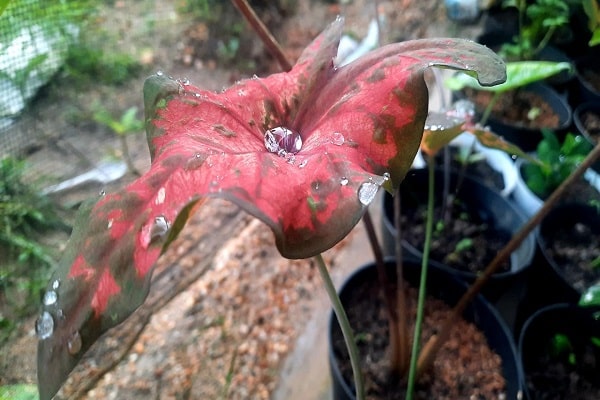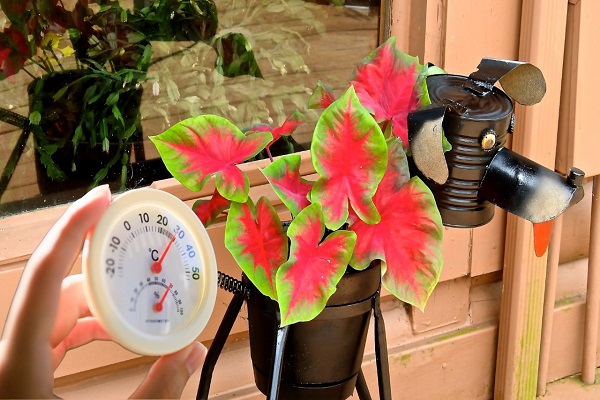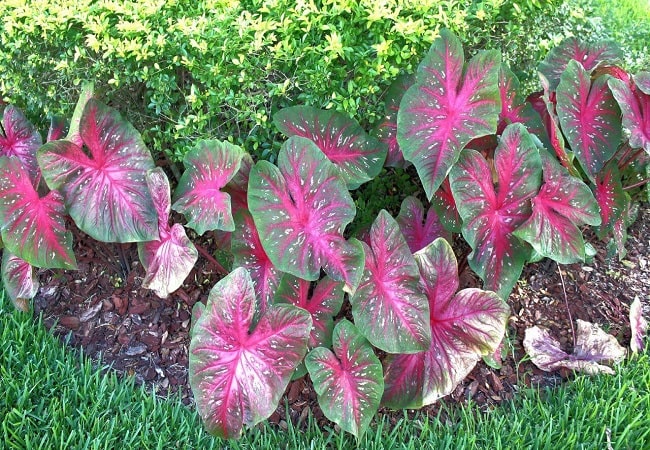Caladium plants look great in homes with thick, vibrant foliage. Their arrow-shaped leaves, angel wings, or elephant ears are a wonderful addition to any plant collection. Caladium plant care over winter are difficult to care for, but these spectacular houseplants will make a statement in the proper location. But what do you do with your Caladium plant when winter comes?
Tropical caladiums cannot resist freezing. Caladiums need protection from winter temperatures below 50 degrees Fahrenheit(10°C). It rests and stops sprouting leaves. Reduce caladium watering and fertilizer. Reduce watering and fertilizing. Potted caladiums can overwinter indoors. Store them in a warm, dry garage or basement.
I will discuss caring for your Caladium plant over winter in this article. Keep reading to find out more!
Quick Navigation
How Do You Know If Your Caladium Is Going Dormant?

Most of the time, it will start when you notice that the big leaves have started to dry out, droop, and die. The plant’s growth slows down, and any new leaves appear sad compared to the young shoots that came out earlier. If you want to be sure that your caladium isn’t dying because of something else, you need to check the soil to ensure it isn’t too wet and look for pests. Suppose it’s fall or winter, and your plant isn’t having any other problems. In that case, it’s just going through the natural sleep process.
Suppose you keep your caladiums outside and live in a particularly cold area where snow and frost are common. In that case, you will need to remove the bulbs from the ground. Leave them in the pot if you overwinter them inside or in a warmer region; they will be ready to sprout new leaves in the spring.
Keep your bulbs cool and dark until planting time if you choose to dig your own rather than purchase them. Three months of dormancy are recommended for every five months of growth beginning in the spring.
Remember The Following When Getting Your Caladiums Ready For Winter

When fall temperatures drop, it’s time to start thinking about how to prepare your caladiums for winter. If you want your caladiums to survive the winter and flourish again in the spring, consider the following advice.
- You must try to keep the room between 50 and 65 degrees Fahrenheit.
- Make sure it’s a dry, sheltered place, not a shed without heat or a garden bench outside.
- Put the bulbs in a box with clean sawdust or sand.
- After dormancy, you can start your bulbs indoors if it’s still a little cold outside.
- Don’t plant caladiums outside until there is no longer a chance of frost.
- To keep your potted caladium plants from drying out, water them at least once a month and put them in a dark place when they enter dormancy.
- Make sure the temperature is always between 50 and 65 degrees Fahrenheit.
- Make sure it’s a dry, safe place, not a garden bench outside or a shed that doesn’t have heat.
- Put the bulbs away in clean sand or sawdust-filled container.
- If it’s still cold outside after the bulbs have been dormant, you can bring them inside to start their growth cycle.
- If you want to plant caladiums outside, you should wait until the risk of frost has passed.
- Make sure to water your potted caladium plants at least once a month, so they don’t dry out. Please keep them in a cool, dark place when they are in their dormant phase.
- Once the caladium’s rest period is over, it will start growing independently. Because of this, you must check on your plants and bulbs often to give them what they need when it’s time for them to grow.
- Once your caladium is no longer dormant, you should go back to your usual care routine for it.
- Caladium bulbs are easy to store and prepare for winter, but you must be more careful if you want to replant them later in the spring.
- When bulbs and caladium plants are dormant, You must keep an eye on them to tell when they are ready to start growing again and thriving.
- Take them out of the cool, dark place, check their pots and replace them if necessary, and give them a lot of sunlight.
The Instruction For Taking Care Of Your Caladiums During The Winter Months
You must take care of your caladiums over the winter if you want them to return the following year. Please follow these basic guidelines:
Caring For Caladium Plants In Humidity

If you decide to keep your caladiums inside, there are certain things you can and must do to help them grow. There are environmental and cultural factors that contribute to these conditions. Caladiums have been grown for a long time in warm climates. Because of this, they need very high humidity levels to do well. In homes with central heating, it’s possible that these plants won’t make it through the winter, but it’s also possible that they will.
Using a humidifier or spraying the leaves with a plant mister glass bottle, you can make it look like these plants are growing in a humid environment. This will make it look like the plants are grown in a damp place. You could also do the same thing with a pebble tray. The evaporation of this liquid, which is found here, gives the area some much-needed extra moisture.
If you can, keep your caladium away from heating vents and radiators. These things will only speed up the drying process of your plant.
Providing The Right Amount Of Light Needed
There are a few things to remember when giving your caladiums the right amount of light. First, caladiums grow best in bright light but can’t grow in direct sunlight. If you live somewhere warm, you can put your caladiums outside in the summer in a shady spot. If not, you will have to use artificial light.
Caladiums do well with fluorescent lights, and you don’t have to worry about them getting too hot if you put them close to the plants. Caladiums don’t do as well with incandescent lights, but you can still use them if that’s all you have. Just make sure the lights aren’t too close to the leaves, so they don’t get too hot and burn them.
If you’re growing your caladium plant inside, you’ll need to ensure it gets enough sunlight, but don’t leave it in the midday sun, or the leaves will get burned.
Caladiums are Goldilocks plants, and you will learn they are very sensitive. Because of this, caring for caladiums in the winter is hard because the sun is often low or the sky is cloudy. Consider buying a lamp that simulates sunlight. This will let you control how much light the plant gets, ensuring it doesn’t get too much or too little.
You could also try to put your caladium plant in front of a northern or eastern window, giving it good light. If it’s an unusually sunny or “scorching” day in the winter, you can always move your plant out of the sun for a while.
The Way To Handle Fertilizer During the Winter
You might want to fertilize your caladium in the winter, but you shouldn’t. It only needs fertilizer in the spring and summer when it’s growing. Don’t feed your caladium in the winter, even though you might want to. You should treat your caladium as if it were a creature that sleeps through the fall and winter. This means you shouldn’t give it any fertilizer or other soil amendments during this time. Think of it instead as something that sleeps.
Even though it’s getting cooler outside, you shouldn’t stop watering your plant. Looking at the plant’s roots, you can tell if the soil is moist enough. Do not water your caladium if the soil is already wet. This could lead to overwatering, root rot, and other problems that plants have when it gets cold and the soil is too wet. Instead, don’t water your caladium until the soil is completely dry. Instead, it would help if you waited to water your caladium until the soil was completely dry.
Most Important Winter Care Tips For Caladium Plants
As a general rule, you should try to keep your caladium where the temperature is about 18°C (64.4°F). If you plan to go away for a few weeks during the winter and won’t be keeping the heat on, you should ask a friend or neighbor to take care of your plant for you. Otherwise, you might come back to a dead plant.
Also, when autumn comes, and the leaves start to turn brown and fall off, you should wait until they do it on their own before cutting off the shriveled parts. This will make sure the leaves die the way they should. When the tubers have reached this point, you can dig them up, put them in the sun to dry out completely, and then store them in peat or a sack. You could also do nothing, leave the tubers where they are, and stop watering your caladium until the following spring.
When spring comes, you must take your tubers out of their peat moss or bags and plant them in new soil. If this is not the case, start watering the tubers where they have grown back in the old pot.
After you’ve picked your new crop of tubers, move the pot to a place with a little more light. The plant will need more sun during the first few months of its regrowth.
Now is the time to decide if you want to keep your caladium outside during the warmer months or not. Move the pot back outside and leave it there until autumn, when you can start the process all over again.
Most Commonly Asked Questions
What Are Caladium Tubers?
Caladium tubers are an important part of the plant’s reproductive process. They are typically found underground and are responsible for storing nutrients and moisture. When the plant dies back in the winter, the tuber is what allows it to regrow in the spring.
Tubers can vary in size and shape, but they all serve the same purpose. The caladium tuber is a vital part of the plant’s life cycle, and without it, the plant would not be able to survive.
Is It Possible To Growing Caladiums Indoors?
Yes, that’s the short answer. Caladiums don’t like cold and frost, so you’ll need to bring them inside during the winter. Caladium tubers are so sensitive to cold that they will die if you don’t bring them inside.
On top of that, caladiums only grow leaves from April to October, when the weather is warmer. During the winter, they are bare and not very nice to look at. Many growers get tired of how bare the stems look during this time and give up on these plants, preferring hardier, low-maintenance species that have leaves all year long.
How Long Before Caladiums Begin To Sprout?
Caladiums are typically planted in late spring, or early summer after the danger of frost has passed. Once the soil temperature rises above 65°F, depending on soil and air temperature, they will begin to sprout within 2-3 weeks. Once they have sprouted, caladiums will continue to grow rapidly, reaching maturity within 8-10 weeks.
When Should I Repot My Caladium?
The ideal time to repot your caladium is every two to three years or when the plant becomes pot-bound. However, you may need to repot more frequently if the plant grows rapidly or if the potting mix is depleted of nutrients. If the roots are crowded and begin to circle the inside of the pot, it is time to repot.
Will Caladiums Come Back Every Year?
Caladiums are perennial plants, meaning they will come back yearly. However, they must be stored properly over the winter to survive and return the following year. If you live in an area with a cold climate, you must store your caladiums indoors over the winter.
Final Touch
When taking care of Caladium plants over winter, keeping them in a cool and dry place is important. They should be kept in a room between 55 and 65 degrees Fahrenheit and not exposed to direct sunlight. You should also keep the plants away from drafts and heat sources.

Plants are my life. I’m a plant whisperer and an amateur gardener who loves to share gardening tips and tricks with you!


